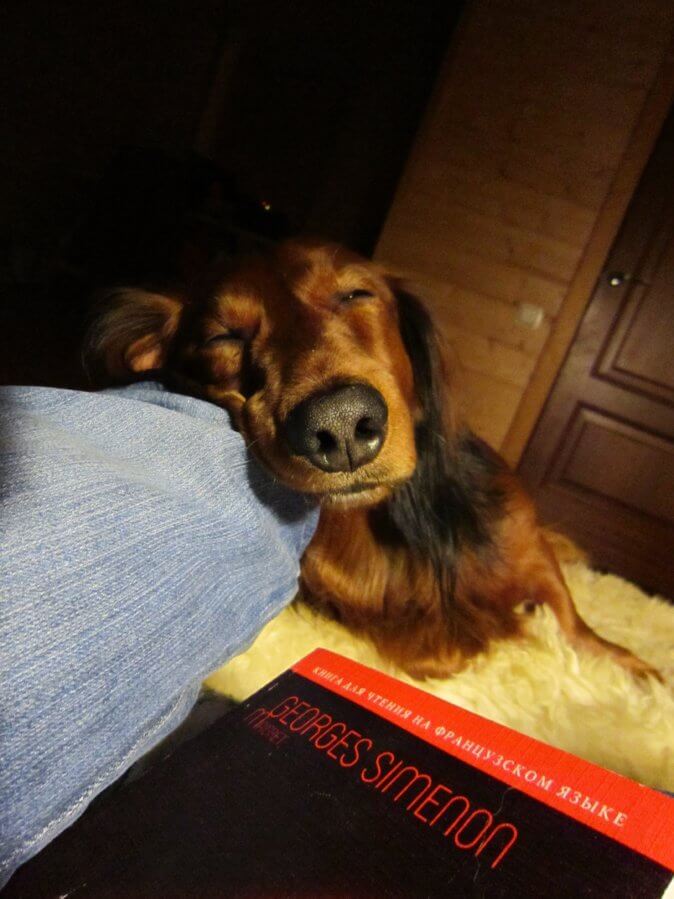Do dogs dream? That’s a question we’d love to answer in this article. If you are a dog owner, you will notice your pet spends the bulk of its day resting. In fact, the National Sleep Foundation says that dogs sleep for at least 12 hours daily (sometimes up to 14 hours). Senior dogs, puppies, and a few specific breeds tend to sleep more daily, between 18 to 20 hours.
This fact begs the question, do dogs dream? Since they spend more than half of their available 24 hours daily sleeping, something interesting must be happening in their minds, right? Do our four-legged buddies experience dreams as we humans do? Let’s discuss this further.
Do Dogs Dream?
This is a question so many are yet to find a definitive answer to. But according to neuroscientist Matt Wilson, it’s pretty evident that many animals experience dreams.
In fact, Matt, who studies memory and learning at MIT, believes that dogs and other animals aren’t very different from humans in regards to experiencing dreams.
Dr. Ann Hohenhaus, who’s a staff doctor at New York City’s Animal Medical Center, agrees that dogs do have dreams.
REM sleeping phase in dogs
As your dog lays outstretched sleeping, paws akimbo, breath spasmodic with increasing eye movement, it’s believed that it’s dreaming.
The rapid eye movement (REM) sleep phase, which is the stage where humans experience dreams actually occur in dogs too.
Twenty minutes after your dog falls asleep, they enter the REM phase. In this period, there’s an increase in brain activity, just like humans. Matt Wilson says this phase is common among all mammals.
Scientists have found that humans and dogs both have the ‘Pons Varolii.’ Ii is a brain structure that paralyses the major muscles once in the Rapid Eye Movement (REM) phase of sleep.
The Pons Varolii paralysis enacted prevents us from excessively moving around (just slight tossing and turning), as well as keep us from ‘acting out’ what we are dreaming.
An interesting twist in this question of whether dogs dream while sleeping is that researchers make use of dogs for studying human sleep and the accompanying sleep disorders.
Do dogs sleep better after exercise?

There have been a series of studies about how dogs sleep and how peaceful they sleep. One study looked into whether dogs sleep better after an exercise or not, and whether they prefer their own bed or a shared bed.
The study found that dogs, in fact, do sleep better after exercise, and they prefer to do so in their bed.
The study measures the quality of sleep by considering the number of time dogs spent in the Rapid Eye Movement (REM) phase.
The result showed that they stayed longer in the REM phase while sleeping on their own bed following a day filled with exercise. Humans also show similar results.
Do animals dream? A study by Matt Wilson
In 2001, neuroscientist Matt Wilson in a quest to compare dreams ‘explored the brain activity of sleeping rats.’
Beforehand, he made a recording of the rats’ brain cells (neurons) while they were actively running through a maze. The results showed that the cells followed a distinct pattern while they were at it.
On comparing with the neurons’ activity when the rats had fallen asleep and were in the REM sleep phase, Wilson noticed the activity pattern were exactly the same and were happening as if the rats were wide awake.
In essence, the rats while sleeping were replaying the days’ activity and race through the maze.
Wilson insists that this behavior of replaying an activity from memory in animals is the same as dreaming in animals, noting that the animals experience these things and perceive these experiences.
Summarily both Wilson and Dr. Ann agree on one thing, which is the fact that dogs dream. But what do they dream about?
What do dogs dream about?

While watching your dog twitch in its sleep, have you ever wondered if it might be dreaming? Can you stop wondering what your pet might just be dreaming about?
You might think that your dog dreams about chasing rabbits or squirrels, but how sure about this are you?
The truth is, we are not entirely sure about dog dreams, yet scientists are constantly making moves for a better understanding of dogs’ dreams.
“Pons” method to understand dog dreams
One method scientists used to determine what dogs might be dreaming about was temporarily making the pons ineffective.
Pons, what are these?
The pons is a set of tissues that are connected to the brain and are responsible for keeping humans and animals from flailing around during sleep.
In other words, when the pons is temporarily inactive during sleep, we cannot act out what we are dreaming about.
If the pons weren’t as effective as they are, we would have been moving about as we dream and might end up harming ourselves or others around us.
Dream movements or slight twitching during sleep is more common among infants and older people. The same applies to puppies and very old dogs.
The reason is the pons isn’t well developed in infants or puppies and becoming inefficient in older people and dogs.
Scientists discovered after disabling the pons of dogs and letting them act their dreams in a controlled environment; they dreamed ‘doggy stuff.’
In other words, their dream pattern seems to be in line with the way humans dream.
Do dogs dreams depend on their breed and size?
The dreams your dog have may depend on its breed and size. According to researchers, a smaller dog normally dreams frequently but for a short duration.
A larger dog wouldn’t dream as much, but when it does, it would be for longer.
A Labrador retriever is discovered to display ball-chasing movements during its sleep more than a Dalmatian will. A Doberman would also display guardian behaviours when dreaming.
To know what your dog MAY be dreaming about, you need to pay attention to get a clue. Most dogs have dreams according to the activities they had during the day.
Are its paws twitching? Is it moving its legs like in a running motion? Is it licking its lips? Random Eye Movement (REM) sleep often occurs after your dog has napped for about 15-20 minutes.
Whatever dream activities your dog exhibits, it will be mostly related to its daily life.
Do dogs have nightmares?

Since dogs’ dream patterns are like that of humans, it is only right to wonder if they have nightmares. The answer is yes! They do! However, as the old line goes, it’s always better to “let sleepy dogs lie.”
When humans have nightmares, a partner, or anyone around can wake them up and comfort them. For instance, you can hold your baby or partner, husband/wife when they have bad dreams and comfort them.
Doing the same for a dog can be deadly and dangerous.
A dog, if awoken from its fit of a nightmare, can be really dangerous and violent. If a child is around or wakes it up, it can be wounded by the dog’s violence. It is best to let it wake up on its own.
A lady once shared a story of how her dog ran to her and hid between her legs. She gave further details that the dog always did that whenever it finished having its bath– something the animal detested so much.
Experts concluded that the dog had probably had a bad dream about its much-hated bath and that motivated that action.
Do dogs dream: Dog crying in sleep
When deep in sleep, a dog may make several reactions, including:
- silent grunts,
- twitching whiskers,
- or even crying.
But what does it mean when your dog cries in its sleep?
It is only dreaming that can make a dog cry in its sleep. Dogs often sleep in two stages.
The first stage is called the slow-wave, which lasts for 10-20 minutes.
After about 20 minutes of napping, a dog slips into the second stage, which is known as REM (random eye movement) sleep phase, which is an intense moment where any form of dreaming happens.
From experience, it is essential to know that crying in the dream won’t hurt your dog in any way and doesn’t mean your dog is having a nightmare.
However, there is a condition known as REM Sleep Behaviour Disorder which compels a dog to act out its dream or nightmare as a reality. This disorder can cause a dog to bump into walls, collapse on furniture, or cry out with a loud and long whine!
The best way to help your dachshund live longer?
Watch our video to find out!
Do dogs dream: Dog twitching in sleep
If you have ever noticed your dog twitching during its sleep, you may be wondering what it means.
Although veterinarians would advise you shouldn’t be alarmed by the situation, we gathered information from other experts and think it might be a sign of an underlying dog ailment.
Firstly, the only reason a dog would twitch in its sleep expert says should be because of dreaming. When dogs lie on their side (especially younger and very old ones), they may dream.
A normal twitching will see your dog making body movements but still lying down – paddling its feet or making small sounds.
Experts say you should visit a vet when the twitching becomes a real movement (large body parts) and it interferes with your dog’s sleep often.
One of the causes of this problem is imbalanced body electrolyte caused by poor nutrition. Neuromuscular conditions like a seizure or tick paralysis can affect your dog and cause excessive twitching.
Another condition that can cause excessive twitching is narcolepsy.
Normal occasional dog twitching during sleep is perfectly normal. However, you should pay attention to your puppies or old dogs, especially to know when the twitching is affecting their sleep routine.
Once it happens more frequently, call your veterinarian immediately.
Is my dog dreaming or having a seizure?

To answer the above question, we need to understand the characteristics of a dog that is in random eye movement sleep, which means it is dreaming and one that is having a seizure.
Signs to watch out for when a dog is dreaming
When your dog decides to hit the sacks, it might just cool for the first 20 minutes tops. If you are observant, you will notice certain characteristics in the following minutes of its sleep.
✓ Random eye movement. When your dog starts dreaming, if you observe it closely enough, you will see its eyes moving beneath the eyelids. Sometimes your dog’s eyes may be fully closed or partially covered during a night of REM sleep.
✓ Twitching. When your dog is dreaming, it might act out all of its dream actions as if it saw it in real life. Your pet might be dreaming of chasing a rat or trying to ward off an intruder.
You will notice it moving its legs in a running motion; however, its overall body posture will look peaceful.
Sometimes it might have random muscle movements and might jerk up a few times, but it will return to its sleepy, peaceful state.
✓ Vocal sounds. Some dogs groan, bark,
✓ Breathing. When your dog is deeply asleep and dreaming, you will notice there will be changes in its breathing pattern. It might hold its breath briefly, breath faster suddenly, or breathe slower. All these happen in an un-orderly manner.
Signs to watch out for if your dog is having a seizure
Seizures affect both humans and animals. Seizures are of two types – the petit mal and the grand mal
The petit mal seizure is that in which just a portion of the body experiences tremors or thwarting. Example of such cases is the fly biting.
The grand mal seizures are those in which all the organism’s body experiences the tremor or thrashing.
While seizures often happen while dogs are awake or a few minutes after waking up, some dogs can become victims while they sleep. The underlying cause of seizures while asleep or awake might be epilepsy, neoplastic growths, or metabolic imbalance.
If you’re confused as to whether your pet is dreaming or having a seizure, here is some enlightenment.
✓ Dreaming dogs can easily be awoken: Although it is not exactly advisable to wake a dreaming dog, they can easily become startled if they were just moving in rhythm with their dreams.
Something like calling its name or making noise can wake it up. However, if your dog is having a seizure, it can only come out of it on its own and wouldn’t awaken that easily.
✓ Loss of control: Do dogs dream and pee or defecate on their selves? No! But when they are under seizures, they do. It may pant, become disoriented, and lose its ability to control its bowels.
What to do if your dog is having a seizure
As a pet owner, you’re advised not to stop your dog from continuing in its fit. Just watch it and be there to comfort it when the seizure passes. A seizing dog wouldn’t even remember a bit of anything that happened later on.
If your dog experiences cluster seizure (happening more than once in 24 hours), do not hesitate to call a vet as soon as possible! However, while at it, you can prevent your dog from overheating by placing a clean cloth soaked in water on its head or around its neck.
Should you wake up a dreaming dog?

It might be hard to stop yourself from waking up your dog when you find it crying, wailing, twitching, or whining in its dreams. In no time it starts moving its legs, and your heart can’t stand it anymore.
It is totally understandable.
However, should you wake a dreaming dog? The answer to this question is ‘probably not.’
The REM sleep patterns of dogs are the same as that of humans. Dogs sleep for up to 16 hours daily and shouldn’t be interrupted when they are having their share of the blissful deep sleep as we do.
However, what if your dog is moving so much and you cannot help but wake it up? Here is how you must do it.
Don’t touch your sleeping dog
When you hear your dog whining or crying like a lonely entity in its sleep, all you may feel like doing is to grab it, hug and comfort it.
You want to lovingly reassure it, and that would involve going close and touching it –but, you should know better than that.
Even if your dog is well trained and very loyal and friendly, it will take it a few moments before it can process its environment once it is startled from its dream.
What that means is when you wake a dog up, you risk being bitten or injured due to scratches.
Wake your dog up with a gentle sound if possible
Have you ever imagined that you were startled out of your sleep by the distressed cry or whine of someone you love dearly?
While you will be dazed momentarily and eager to go help your loved one at the same time, your dog would feel the same way in such situations.
If you see your dog dreaming and making sounds and can no longer bear it, the first instinct might be to yell its name. Don’t do it.
If you yell and startle your dog, it will automatically go into a guardian mode and think something is wrong with its owner. Since it might take time to figure out its surrounding, the dog might like lunge at you and cause harm.
If you must call its name, make it as gentle as possible. If you must make other sounds, make them as soft as possible too. A soft noise or tone would help it safely leave its dream to a safer mode for waking up.
The only time you can touch your dog is after it has been safely brought out from dreamland. You can scratch its head, kiss its face, and tell it that everything is safe.
If you want to find out how much sleep your puppy or older dog needs, read our detailed article How much sleep do dogs need.


